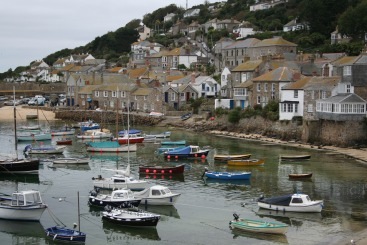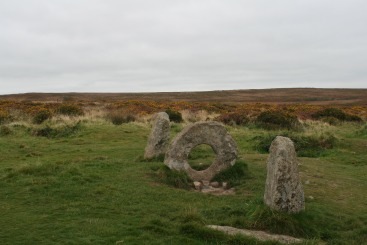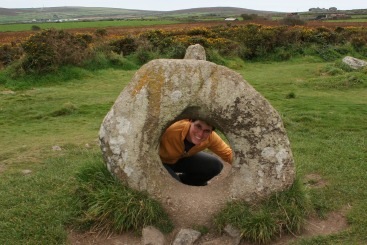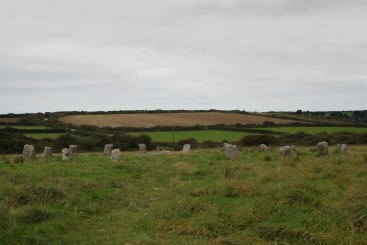 Tuesday 29 Sep
Tuesday 29 Sep
There are many things more dangerous than British motorways.
These include the tiny lanes that seem to comprise the entire road network of the southern-most end of Cornwall. Here, anything above 10mph is an excessively dangerous speed, and if you meet anything larger than a Matchbox car coming the other way you are in BIG trouble.
The town of Mousehole (pronounced Muzzle, and named, I presume, for the narrow gap in the breakwater which allows small vessels entrance into the sheltered harbour behind) is a case in point. When one car encounters another there is much manouevring and reversing required to allow one to get past the other, and I have absolutely no idea how buses manage to negotiate the narrow sharp corners … even though I watched a driver do it. (Fortunately I wasn’t in my car going in the opposite direction at the time!)
My experiences with the tourists in Mousehole highlighted once again the Heisenberg Tourist Effect. As some of you may know, the Heisenberg Uncertainty Principle states, basically, that the process of measuring something (e.g., position) affects some other attribute (e.g., momentum). More loosely, the process of observing something affects aspects of that something. My Heisenberg Tourist Effect is that the process of observing a nice place actually changes the place, e.g., by turning it into a “tourist attraction”, with a resulting detrimental effect on its “nice place” status. The more observers there are, the worse this effect.
This was spectacularly evident at Land’s End (the English nomenclature board believes in apostrophes, apparently). I drove into the carpark (massive), saw the garish hotel and shops, and turned around and headed back out again. I couldn’t stand it.
Mind you, I will have to take responsibility for causing the Heisenberg Tourist Effect at Mên-An-Tol (literally “rock with hole”), as shown below (N 50° 09.400 W 005° 35.900). Those of you marvelling at the alignment of the three stones (ignoring the alignment of the goon in the second photo) need to bear in mind that the stones have been moved, and that they used to be in some sort of triangular arrangement … and there was at least one other stone involved.


 Hmm, I seem to have rambled for several paragraphs without making the heading clear.
Hmm, I seem to have rambled for several paragraphs without making the heading clear.
I spent a goodly portion of today going in search of quoits. These are, I believe, the inner stone burial chamber parts of Neolithic barrows or mounds.
I “collected” three of them, one of which is shown at right (Chun Quoit, at about N 50° 08.900 W 005° 38.150). There are very dramatic; this one and one of the others that I found were at the tops of hills and commanded good views.
I took photos of the others and have included them in of those separate photo-pages that I have been doing. I spent half an hour or so preparing it … and I have just discovered that I can’t upload the page. This may have to wait until I get back to Oxford. Sorry about that, folks. I’ll let you know as soon as they are available. UPDATE: 10 bonus photos now available here.
 The other interesting “ancient” site I saw was a stone circle, known as the Merry Maidens. This has a later legend associated with it, concerning nineteen maidens who were turned to stone for dancing on a Sunday. Their two musos ran away … and got turned to stone in a neighbouring field. (I reckon they all just fell asleep in a particularly dull Sunday School lesson ………. quick, where are some rubber-soled shoes!!) To give you a sense of scale, these stones are about 1m high.
The other interesting “ancient” site I saw was a stone circle, known as the Merry Maidens. This has a later legend associated with it, concerning nineteen maidens who were turned to stone for dancing on a Sunday. Their two musos ran away … and got turned to stone in a neighbouring field. (I reckon they all just fell asleep in a particularly dull Sunday School lesson ………. quick, where are some rubber-soled shoes!!) To give you a sense of scale, these stones are about 1m high.
Finally, the day had some coastal scenery as well, away from the madness of Land’s End. Near Guennap Head there are some spectacular granite formations on the cliffs (N 50° 02.200 W 005° 40.700), and there’s also a lovely little beach where two tunnels have been carved though a small headland.
If anyone has ever read (and remembers) Hammond Innes’ The Trojan Horse, the cones of Runnel are located here. These are two big marker cones up on the cliff, one of which is just like a 4m tall orange traffic cone/witches’ hat. These highlight the seaward location of a dangerous rock, and were a clue in the book for where the high-powered engine so needed for the war effort was hidden.
Why can’t I remember useful things!


Finally,
- Yes, aspects of Cornwall are like Newfoundland, only less brightly coloured due to Cornish use of stone in the buildings in contrast to the Newfoundlanders’ vibrantly painted timber;
- Every town in Cornwall starts with Tre- or the letter P (alright, there might be the odd one or two or three … or many … exceptions … but the Tre-s and Ps are pretty common).
- GPS coords are only approximate.
 Helen Chick
Helen Chick
I didn’t make it as far as Cornwall :(. but the first time I drove the hire car in Oxfordshire, a car coming the other way in some tiny village clipped the driver’s side wing mirror and smashed it off! I can soooo relate to what you’re saying. The wing mirror pretty well sunk my driving confidence in the UK and I did very little for the next 12 months – except for a memorable occasion going down a steep hill towards a Roman ruin, hundred feet drop on the off side, no guard rail, and was told by D to reverse back uphill and onto the verge by the drop I couldn’t see to allow another car past. The air was more than blue!
Neolithic stones I found really spooky and mysterious. Roman or Saxon ruins I can relate to (house, temple, baths, fort, grave) but the standing stones are so alien and we don’t really know what they mean. There’s a huge ring of big (taller than me) stones in Avebury (Wiltshire) where the village is now in the middle of the ring and the sheep graze around the stones! Try visiting Stonehenge in the fog – it’s positively creepy! (and there are fewer tourists).
Consider yourself a traveller – a different creature to those tacky tourists who gunge up all the formerly nice places.
Ooh, I love the first picture. It does look like Newfoundland, but less colorful.
Doug says in Cornish (which is related to Welsh), “Pen” means head (or headland), and “Tre” means something too, but he’s not sure what.
Cool quoits!
Nice to see the blog post and photos! And of course I look forward to more of both. I’d already read your ‘found’ logs and uploaded them to GCA. 🙂
Helena J: I love the fact that somewhere among my friends I can find an expert on just about anything!
Snuva: Thanks so much for that. I was going to do a bulk upload at the end of this week when I had a bit of time (I’m not the world’s fastest blogger, especially when you include the time spent sorting through photos). I should have interesting “12 of 12″s for the next three months (provided I remember!)
Ooooh aaaarrrr! There’s a nice bit’a archeology down ‘ere! It fair takes your breath away, ‘ey Tony!
[…] It was worth the visit, and we were able to see quite a few of the famous sites, but we did rather ruin it for ourselves by cluttering up the place with tourists in yet another example of the Heisenberg Tourist Effect. […]